Introduction
India is a land of festivals, where every occasion has deep spiritual, cultural, and social significance. Among all these sacred celebrations, Chhath Puja holds a unique place, especially in the states of Bihar, Jharkhand, Uttar Pradesh and Nepal’s Terai region. This festival is a symbol of faith, discipline, and gratitude towards Lord Surya (the Sun God), who sustains life on Earth. Unlike most other Hindu festivals that involve idol worship, Chhath Puja is about direct connection with nature—especially the setting and rising Sun.
The Meaning of Chhath Puja
The word “Chhath” comes from the Sanskrit word Shashti, which means sixth. The festival is celebrated on the sixth day of the lunar month of Kartika (October–November), just after Diwali. Devotees worship Surya Dev and Chhathi Maiya, believed to be the sister of the Sun God, who is regarded as the goddess of energy, fertility, and well-being.
This four-day festival involves rigorous fasting, purity, and offering prayers to thank the Sun God for providing life and energy to Earth. It’s not just a ritual—it’s a spiritual journey of devotion, self-discipline, and purity.
Historical and Mythological Significance
The roots of Chhath Puja can be traced back to ancient Hindu scriptures and legends:
- Ramayana Connection – According to Hindu mythology, Lord Rama and Goddess Sita observed a fast and offered prayers to the Sun God after returning to Ayodhya from exile. This ritual took place on the sixth day after Diwali, which later became Chhath Puja.
- Mahabharata Connection – Another legend mentions that Draupadi and the Pandavas performed Chhath Puja to seek divine help and regain their lost prosperity. Their devotion and penance are said to have brought blessings.
- Vedic Link – In Vedic times, Sun worship was a form of energy healing. Offering Arghya (water offering) to the Sun was believed to improve mental and physical well-being; sages practiced these rituals to absorb solar energy as a source of healing and life.
Rituals and Observances of Chhath Puja
The festival lasts four days, and each day has its own spiritual and physical discipline:
-
Nahay Khay (First Day)
Devotees take a holy bath, often in a river or pond, and clean their homes. The day begins with purity and preparation. They eat a single simple meal—usually rice, lentils, and pumpkin—cooked without onion or garlic.
-
Kharna (Second Day)
On this day, devotees observe a fast throughout the day and break it after sunset with gur ki kheer (jaggery pudding) and fruits. After that they begin a 36-hour nirjala fast (without food and water) as a mark of devotion and self-control.
-
Sandhya Arghya (Third Day)
The most important day—devotees gather at riverbanks or ponds at sunset to offer Arghya to the setting Sun, expressing gratitude for sustaining life. Women sing traditional folk songs and prayers, creating an atmosphere of devotion and unity.
-
Usha Arghya (Fourth Day)
On the final day, devotees offer Arghya to the rising Sun, marking the end of the fasting period. The ritual symbolizes hope, renewal, and the beginning of a new life filled with positive energy. After prayers, devotees break their fast with thekua, fruits, and prasad.
Spiritual Significance
Chhath Puja is a festival of purity, self-discipline, and harmony with nature. It reminds us of the importance of the five elements—Earth, Water, Fire, Air, and Space—and how they sustain life. The fasting and water rituals help detoxify the body and purify the soul.
The Sun is worshipped not only as a deity but also as the eternal source of light, energy, and health. Performing Chhath strengthens mental focus, patience, and faith, connecting humans directly with cosmic forces.
Social and Cultural Importance
Chhath Puja goes beyond private devotion—it's a social celebration that reflects unity and equality. People from different backgrounds come together on riverbanks to offer prayers, promoting communal harmony. In many rural areas, communities clean and decorate local ponds and ghats, while traditional songs and folk performances create a festive spirit.
Modern-Day Relevance
Even in modern urban life, Chhath Puja reminds us to respect nature and maintain balance. Families celebrate on rooftops, balconies, or artificial ponds when access to natural water bodies is limited—demonstrating how faith adapts while preserving core values of gratitude, discipline, and harmony.
Chhath also promotes environmental awareness by encouraging cleanliness of water bodies and discouraging pollution—showing that traditional rituals can align with contemporary sustainability goals.
Conclusion
Chhath Puja is a celebration of faith, purity, and devotion. It honors the Sun God, who sustains all life, and reminds us of our connection with nature. The festival teaches patience, gratitude, and balance—qualities needed in today’s fast-paced world. In the glow of the rising and setting Sun, devotees see not just light but divine energy—the energy that illuminates hearts and strengthens the soul. Chhath Puja is not just a festival; it’s a way of life—a moment to pause, reflect, and give thanks for the countless blessings we often take for granted.

